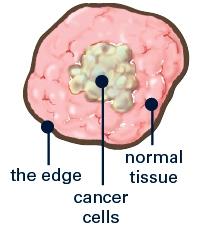The most uncomfortable and anxiety producing part of my lumpectomy, for my first breast cancer, occurred hours before my surgery. The breast needle localization, as it is called, is a common practice procedure in which the radiologist inserted a needle with a fine wire into my breast to map the location of the cancer. The wire remained in my breast, poking out of the skin, to guide the surgeon during my surgery.
 I was pleased to read about a patient friendlier method of pinpointing breast tumors that are visible in a mammogram but not palpable in physical examination. This procedure proved itself in clinical trials and is being used in several major cancer treatment centers around the U.S.
I was pleased to read about a patient friendlier method of pinpointing breast tumors that are visible in a mammogram but not palpable in physical examination. This procedure proved itself in clinical trials and is being used in several major cancer treatment centers around the U.S.
The procedure, called radioactive seed localization, begins with a breast radiologist injecting tiny sealed radioactive sources called “seeds” into the patient’s breast to mark the exact location of the cancer. The radiologist can perform this image-guided procedure up to two weeks before a biopsy or lumpectomy.
Once in the operating room, surgeons use a handheld radiation detection device, developed specifically for this procedure, to zero in on the seed and precisely navigate to the location of the cancer, which is removed along with the seed during the operation. After the procedure, there is no radioactivity remaining in the body. A pathologist ultimately takes the seed out of the breast tissue in the laboratory, and radiation safety officers ensure the seed’s safe disposal.
Studies suggest that radioactive seed localization results in more precise removal of small breast cancers as compared to traditional breast needle localization. It also reduces the need to have a second surgery due to incomplete removal of the abnormal tissue.
A video by Dr. Monica Morrow, Chief of the Breast Surgical Service at Memorial Sloan-Kettering, NYC explains how the procedure is done at Sloan. She speaks to the benefits of this procedure over breast needle localization. “Seed localization has improved our patients’ experience by allowing them to go directly to the operating room on the day of their lumpectomy. It is more convenient because it avoids the need for a wire in the breast for several hours, which many patients find uncomfortable.”
The use of this technique at Memorial Sloan-Kettering was initiated by Chief of the Breast Imaging Service, Elizabeth Morris and Jean St. Germain, an attending physicist and radiation safety officer at Memorial Sloan-Kettering. It is standard practice for the majority of Memorial Sloan-Kettering’s patients with small breast cancers.
“Getting this technique up and running took months of training and coordination among experts in radiology, surgery, medical physics, and pathology to make certain that the procedure would be safe and effective for our patients,” St. Germain said, “This collaboration has ultimately improved our efficiency as well as provided a better surgical experience for our patients.”
Sources: Press releases, Video by Dr.Monica Morrow, Chief of the Breast Surgical Service at Memorial Sloan-Kettering

